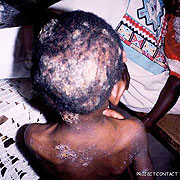Human scabies is caused by an infestation of the skin by the human itch mite called sarcoptes scabies. Human scabies is caused by an infestation of the skin by the human itch mite, the adult female scabies mites burrow into the upper layer of the skin (epidermis) where they live and deposit their eggs.


Human scabies is caused by an infestation of the skin by the human itch mite called sarcoptes scabies. Human scabies is caused by an infestation of the skin by the human itch mite, the adult female scabies mites burrow into the upper layer of the skin (epidermis) where they live and deposit their eggs.
The microscopic scabies mite almost always is passed by direct, prolonged, skin to skin contact with a person who already is infested.
An infested person can spread scabies even if he or she has no symptoms. Humans are the source of infestation; animals do not spread human scabies.
Scabies can be passed easily by an infested person to his or her household members and sexual partners. Scabies can spread easily under crowded conditions where close body and skin contact is common.
Institutions such as nursing homes, extended-care facilities, and prisons are often sites of scabies outbreaks. Child care facilities also are a common site of scabies infestations.
When a person is infested with scabies mites the first time, symptoms usually do not appear for up to two months after being infested; however, an infested person still can spread scabies during this time even though he or she does not have symptoms.
If a person has had scabies before, symptoms appear much sooner after exposure. An infested person can transmit scabies, even if they do not have symptoms, until they are successfully treated and the mites and eggs are destroyed.
Symptoms
The most common symptoms of scabies, itching and a skin rash are caused by sensitisation to the proteins and feces of the parasite. Severe itching (pruritus), especially at night is the earliest and most common symptom of scabies.
A pimple-like (papular), itchy (pruritic) scabies rash is also common. Itching and rash may affect much of the body or be limited to common sites such as between the fingers, wrist, elbow, armpit, penis, nipple, waist, and buttocks.
The head, face, neck, palms, and soles often are involved in infants and very young children, but usually not adults and older children.
Prevention
Scabies is prevented by avoiding direct skin to skin contact with an infected person or with items such as clothing or bedding used by an infested person.
Scabies treatment usually is recommended for members of the same household, particularly for those who have had prolonged skin to skin contact.
All household members and other potentially exposed persons should be treated at the same time as the infested person to prevent possible re-exposure and re-infestation.
Bedding and clothing worn or used next to the skin anytime during the 3 days before treatment should be machine washed and dried using the hot water and hot dryer cycles or be dry cleaned.
Items that cannot be dry cleaned or laundered can be disinfested by storing in a closed plastic bag for several days to a week.
Scabies mites generally do not survive more than 2 to 3 days away from human skin.
Treatment
Products used to treat scabies are called scabicides because they kill scabies mites; some also kill mite eggs. Scabicides used to treat human scabies are available only with a doctor’s prescription.
Always contact a doctor or pharmacist if unsure how to use a particular medicine.
Scabicide lotion or cream should be applied to all areas of the body from the neck down to the feet and toes.
In addition, when treating infants and young children, scabicide lotion or cream also should be applied to their entire head and neck because scabies can affect their face, scalp, and neck, as well as the rest of their body.
The lotion or cream should be applied to a clean body and left on for the recommended time before washing it off. Clean clothing should be worn after treatment.
Ends


